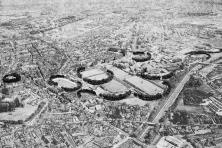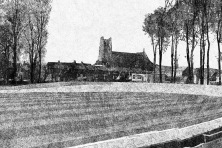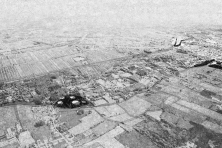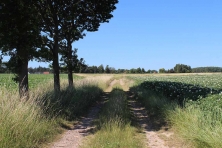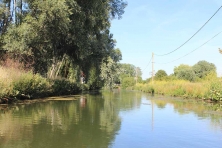9 places to the sea
Saint-Omer (FR) - Runner-Up
TEAM DATA
Team Representative: Mathieu Labeille (FR) – landscaper
Associate: Ségolène Merlin Raynaud (FR) – architect
GRANDTOUR Art & Paysage
54 rue du Taur, 31000 Toulouse (FR)
+33 6 83 26 57 82 – mathieu.labeille@grandtour-paysage.fr – www.grandtour-paysage.fr
See the complete listing of portraits here
See the site here

Ségolène Merlin Raynaud, Mathieu Labeille
VIDEO (made by the team)
INTERVIEW
1. How did you form the team for the competition?
Our team was built around a series of common desires : to progress in our respective ways of doing projects, but also to advance in certain precise questionings that we had about landscape and contemporary urban development.
2. How do you define the main issue of your project, and how did you answer on this session main topic: the place of productive activities within the city?
In Saint-Omer, we were guided by an extremely simple intuition. It seemed to us that it was necessary to refocus the question around an essential principle: above all, water produces art. This is an idea that we've grasped in a broad way, to evoke both the art of life specific to the territory as well as the particular landscape art that we meet there, in marsh or in the city. From this starting point, using landscape art as the support of a discussion with the territory, we sought to compose the strongest and freest possible project. We therefore did not so much question the place of productive activities within the city as the place of man, and therefore of the city, in a territory very strongly marked by water.
3. How did this issue and the questions raised by the site mutation meet?
For our team, the 5 sites were seen as decisive sequences on which to act in order to renew and perpetuate the relations between the city and its landscape. As such, we considered that they could be used as models. The evidence of this exemplary character appeared to us very early and allowed us to constantly question the relationship between the small and the large scales. Beyond that, it is mainly the question of displacement in the landscape that gave us the tools to make such a crossing : by replacing the 5 given places in a larger system, that of the great path of the Aa going from upstream to downstream, by adding 4 other sites at the ends and at the heart of the device then by asking ourselves the question of their transformation through the landscape project, we constantly brought the main themes and the sites into dialogue.
4. Have you treated this issue previously? What were the reference projects that inspired yours?
In a discipline like landscape, that's so transversal and so site-dependent, it is difficult to mention any specific project references. However, our work was built around a very large corpus of works : • on the one hand, the extraordinary archive views available to us, those of the marshes of course, but also those of the city fortifications, which had planted structures of a rather exceptional size, • on the other hand, the ancient works of art representing Saint-Omer, in the forefront of which are Corot's canvases and drawings by Turner or Bonnington, • and finally, a series of freer references, in relation to our project intuitions, touching both contemporary art - from Mary Miss to Maya Lin, from Hamish Fulton to Thomas McIntosh - or cinema - from Peter Weir to Abbas Kiarostami.
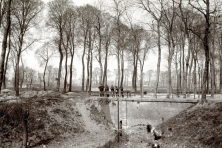
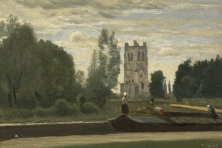
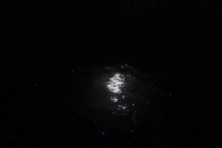
5. Urban-architectural projects like the ones in Europan can only be implemented together with the actors through a negotiated process and in time. How did you consider this issue in your project?
This is undoubtedly the central question. In this field, we have sought to combine revitalization of the territory, involvement of the population , economic viability of the intervention... In July 2019, a few weeks before the end of this work, we redid ourselves for two days the project tracking experience. Between the existing routes - GRP, agricultural trails - and those to be invented, we were therefore able to verify the feasibility of the proposal. In the light of this raw material, we have acquired the conviction that from the start of the studies, landscape and urban walks could very easily be initiated, in order to test and sketch the final route of this great water path. A specific discovery event, such as a traveling Biennale, could be set up in the process - evoking both the Loire Estuary Route and the Marseille route of the GR2013. These initiatives would help create a new territorial dynamic, centered on the landscape and on the sites identified in EUROPAN 15.
6. Is it the first time you have been awarded a prize at Europan? How could this help you in your professional career?
Yes, this is the first time for each of the two team members. Our participation in the Europan competition was first thought of as a means of crystallizing and deepening the questions that we have been dealing with for a long time - that of the relationship between landscape, representation and project for one, that of walking and traveling in the landscape for the other. Beyond that, each in our own way, we consider this Europan 15 experience as a decisive step in the invention and the consolidation of our respective ways of thinking.
TEAM IDENTITY
Office: Grandtour Paysage - Toulouse (FR), Ségolène Merlin Raynaud
Function: Landscaper, architect
Average age of the associates: 35 years old
Has your team, together or separately, already conceived or implemented some projects and/or won any competition ? If yes, which ones ?
Together, no, even though there were collaborations at the time we were both working for MDP – Michel Desvigne Paysagiste in Paris, notably on the Guide Plan for Public Spaces in Downtown Marseille. Mathieu Labeille, within GRANDTOUR Art & Paysage: Montauban Downtown Landscape Guide Plan (2019), Cent dessins de paysage, livre d'artiste (2016). Ségolène Merlin Raynaud: Competition Up Trouville, Nominated project.
